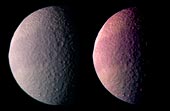|
COMETS EARTH JUPITER KUIPER BELT MARS MERCURY METEORITES NEPTUNE OORT CLOUD PLUTO SATURN SOLAR SYSTEM SPACE SUN URANUS VENUS ORDER PRINTS
PHOTO CATEGORIES SCIENCEVIEWS AMERICAN INDIAN AMPHIBIANS BIRDS BUGS FINE ART FOSSILS THE ISLANDS HISTORICAL PHOTOS MAMMALS OTHER PARKS PLANTS RELIGIOUS REPTILES SCIENCEVIEWS PRINTS
|
Related Document
Download Options
This is the best color image of Tethys taken by the Voyager 1 spacecraft. It was produced by combining three images taken through orange, green and blue filters. The image on the right has been color and contrast enhanced in order to emphasize the dark band that stretches across the satellite. The exact cause for the dark band is unknown, but a possible interpretation comes from recent Galileo images of Jupiter's moons Ganymede and Callisto. Both satellites exhibit light polar caps that are made from bright ice deposits on pole-facing slopes of craters. From a distance the caps appear brighter due to a haze caused by thousands of unresolved patches of ice in small craters. The dark band on Tethys may have been formed in a similar manner, consisting of hazy polar caps of unresolved bright ice patches with a dark zone in-between. Another notable feature is the bright terrain along the limb in the upper left-hand corner of the image. This is a cross section through the giant Odysseus impact basin and shows the fact that the crater must have been formed at a time when the ice was still relative warm and soft. The crater no longer shows deep bowl shape characteristics of craters formed in cold ice or rock. |
||||||||||||||||||||||||||||||||||
